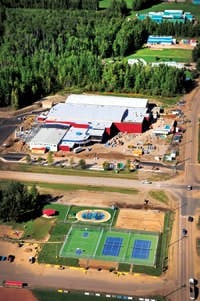The Northern Rockies region of northeastern British Columbia, Canada, boasts significant wealth and diversity of natural resources, heritage and cultural attributes.
Over the past four decades, the region has experienced “up and down” cycles due to the growth and decline of numerous resources and development activities. There have been interesting development proposals, such as the Horn River Shale Gas Development, a working partnership that would link the Northern Rockies Regional Municipality (NRRM), Fort Nelson and First Nation communities with the oil and gas industry and provincial government agencies.
Water Treatment System Configuration
In support of this partnership, the NRRM water and wastewater treatment facilities—comprising a network of pump houses and other facilities—produces the treated water needed to run the operations of the oil and gas patch and forest and mining activities, in addition to serving its population of about 5,000 residents. A bulk water station furnishes water for those who are not on municipal water and to the trucks that transport water to operations in the oil and gas patch, for activities such as hydraulic fracturing.
“Fort Nelson has a fully automated bulk water station, which delivers an average of 14,125.9 cu ft (400 cu meters) of treated water for residential and industrial usage daily,” said Michael Ferguson, electrical and automation specialist for NRRM. “This station is fully integrated into the municipality’s SCADA system, which facilitates monitoring of flow totalization, alarming of heat trace and boiler systems, as well as trending chlorine residual levels in the water being dispensed, etc.”
According to Ferguson, the municipality recently moved to PcVue for use with its SCADA system. Fort Nelson’s SCADA system also includes 22 Motorola ACE remote terminal units (RTUs) at various pump and lift stations, which communicate over a 900-MHz IP radio network.
“We have two Motorola IP gateways (of the Ace3600 platform), which are primary and redundantly configured,” Ferguson said. “The IP gateways are the interposing link between the network of field RTUs and the managing servers (also redundantly configured). Our servers are located at the municipality’s water treatment plant.”
Through the help of its value-added reseller, CTH, the team chose the hardware-independent PcVue SCADA package, which integrates seamlessly with CTH’s IM-SCADA, an advanced multiprotocol measurement and communication software. “CTH Systems provided the key component [the IM-SCADA driver software] that allowed for a quick transition to PcVue,” Ferguson said.
CTH used PcVue’s SCADA application builder tool, the Smart Generator, to port Northern Rockies applications to a more secure and robust SCADA architecture. PcVue and IM-SCADA
software sit on these servers as well as the
historical databases.
Resource Municipality
The Fort Nelson facility also happens to be British Columbia’s first and only “resource municipality” to service local industry, residents and businesses. It covers more than 10% of the province and includes the majority of the vast Horn River Shale Gas Development. Ferguson manages the electrical systems, process control, automation and communication component of the municipalities’ water and wastewater infrastructure.
Currently, Fort Nelson’s SCADA system manages about 8,000 tags. With ongoing capital
projects such as a new ultraviolet disinfection station to treat wastewater effluent, the system
is poised for growth.
Fort Nelson’s water treatment process begins by drawing raw water from the Muskwa River, downstream of the Alaska Highway bridge crossing. There are several critical processes involved in filling the municipalities’ raw water reservoirs. The initial pumping of the raw water from the Muskwa River requires multi-stage pumping with PID control to overcome tremendous head pressure and control variable flow rates.
“The process of treating water is not a static process for us,” Ferguson said. “Process variables such as turbidity, color and organics are influenced from things such as weather events. For instance, we once experienced a mudslide where the river we pump raw water from was impacted.”
Report & Trend Generation
CTH has provided engineering support to allow the municipality to export data in the form of .csv files to a report and trend generation service called FlowWorks, which conditions incoming data with various algorithms such as time-weighted averaging, allowing for the municipalities’ non-operations personnel to view trends and generate reports. Additionally, CTH has provided real-time and historical trending as an inherent feature of the IM-SCADA driver. This feature presents the data needed to make decisions on how to best optimize operations.
As Ferguson further works to develop the potential of Fort Nelson’s water and wastewater SCADA system, he plans to integrate PcVue
with other management applications, such as the work order system.
“The goal of our responsible management and preventative maintenance philosophy is to ‘bundle’ systems like SCADA, PDAs, and work order application software together,” Ferguson said. “To responsibly operate and maintain a productive multi-million dollar infrastructure such as ours, [we are required to combine] the use of technologies, the efforts of personnel and a forward-thinking approach.”
Ferguson is working to achieve automatically generated work orders based on pump run times and pressure changes that indicate wearing seals, etc. In addition, he would like the ability to view system data such as alarms, pressure and levels from a mobile device such as an iPhone—which is now possible with the latest version of the IM-SCADA driver.
“Having the freedom to access real-time system data from a mobile phone is a welcome feature, which will get a lot of use from operators at NRRM,” Ferguson said.
PcVue is configured for one mimic per site, along with pop-up windows in the event that additional details and certain critical values can be accessed by operators with a click of an icon.
“We have multiple mimics built in PcVue that facilitate the various exchanges between the operator and host,” Ferguson said.
PcVue will contribute to Fort Nelson’s effort to reduce reactionary repairs and unexpected equipment replacement. This is achievable by tailoring alarm and reporting functionality to expose issues at their incipient stage. The use of a fully automated SCADA system is essential in downtime prevention in water and wastewater services provided by this growing municipality.
Download: Here


